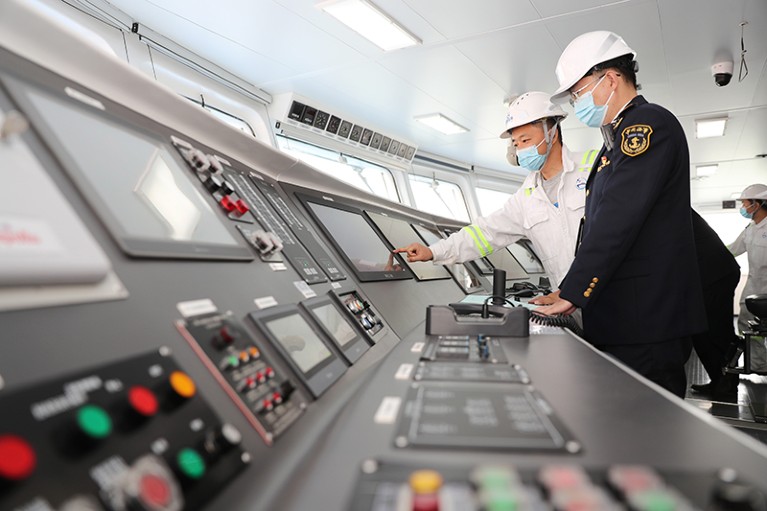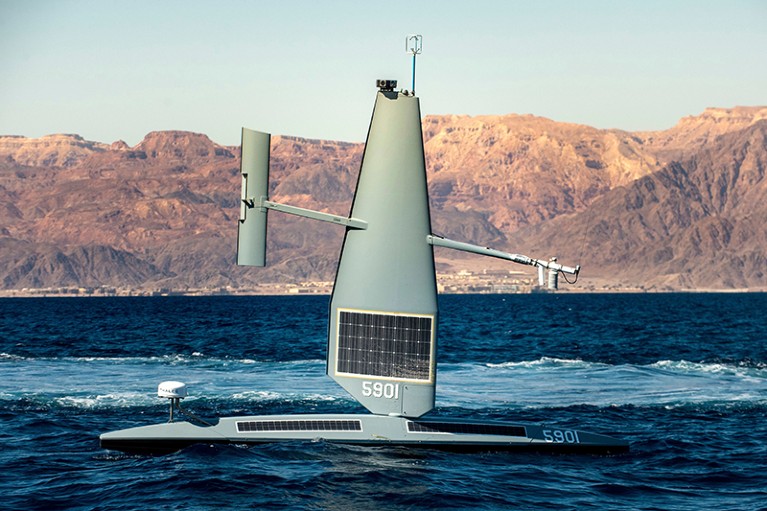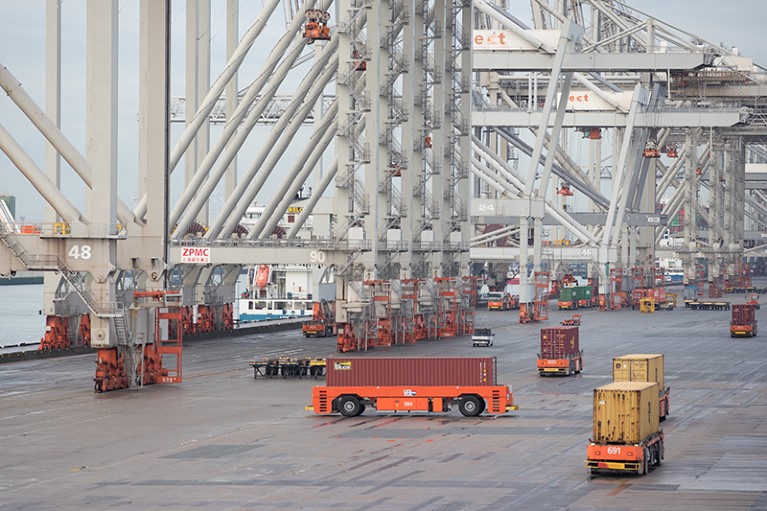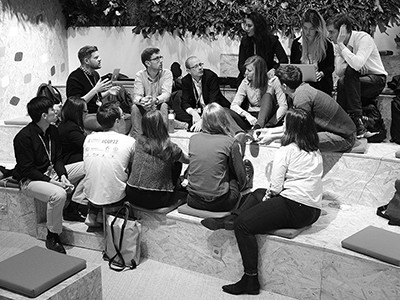In January last year, a Japanese car ferry, the Soleil, became the first large vessel to navigate without human intervention. The 220-metre-long ship automatically berthed and unberthed, turned, reversed and steered itself for 240 kilometres across the Iyonada Sea from Shinmoji in northern Kyushu — manoeuvres that even skilled human operators find challenging.
It is early days, but ships are increasingly deploying sensors and artificial-intelligence (AI) systems to navigate, steer and avoid collisions. As with cars, such advances should improve safety, increase efficiency and — along with cleaner fuels and engines — reduce environmental impacts.
This is crucial: 80% of global trade (around 11 billion tonnes) is transported by sea each year1. In 2018, shipping generated around 3% (about 1,000 million tonnes) of global carbon dioxide emissions2. The International Maritime Organization (IMO) has committed to halving the industry’s greenhouse-gas emissions by 2050.
Seafaring is risky and workers are in short supply. Inefficiencies and congestion at ports add delays and costs, as do accidents, such as the grounding of the container ship Ever Given in the Suez canal for six days in March 2021. Streamlining passage through locks, reducing energy consumption and negotiating manoeuvres to avoid collisions would enable safer and more optimal use of waterways.
Some small, fully autonomous boats, typically less than 10 metres long, are already in operation for specialist tasks such as monitoring water quality and infrastructure in the open sea, or as test beds for the technology. But the next couple of years will see a sea change, with the first larger ‘maritime autonomous surface ships’ planned to start commercial operation.
A cleaner future for flight — aviation needs a radical redesign
Pilot projects include the Norwegian container ship Yara Birkeland, an 80-metre-long vessel that, by 2024, is expected to convey fertilizer autonomously and with zero emissions from a manufacturing plant to an export port. In China, a 120-metre-long electric container ship called Zhi Fei has been demonstrated shuttling under remote (and sometimes autonomous) control between two ports in Shandong province.
In a decade, automated vessels might interact with one another. For instance, the Vessel Train, a pilot project funded by the European Union and coordinated by the Netherlands Maritime Technology Foundation in Rotterdam, uses a crewed lead vessel to head a convoy of smaller, automated ones that can access small waterways around ports efficiently. Ultimately, fleets of self-steering ships or boats might be managed from maritime traffic-control centres located on shore.
But if autonomous vessels are to fulfil their promise, much remains to be done — and soon. More than 50,000 merchant ships trade internationally, under the flags of some 150 nations. A large, high-tech vessel can cost US$200 million to build, and can operate for decades. Ships are complex technically. They need to work in busy shipping lanes, ports and rough open seas.
Combining maritime systems is daunting — from radar, satellites and GPS, cameras and sensors, to image recognition, data analytics and machine-learning algorithms. And autonomous ships need to be plugged into a broader ecosystem of maritime technologies, including interactions between ships and with cargo handlers, equipment, pilots, traffic services and ports.
Here, we highlight research gaps in six key areas.
Understand the challenges at different levels of autonomy
The roll-out of increasing levels of autonomy needs to be managed to assure safety and to allow regulation to keep up. Operational guidelines are needed for vessels in the four classes of autonomy defined by the IMO.
The first challenge is to add sensors and algorithms based on AI and deep learning to the autopilot systems that are currently used on some crewed ships and boats — classed as IMO autonomy level one. Obstacles such as small boats, debris, swimmers and riverbanks do not appear on radar or on the global ‘automatic identification system’ (AIS) that tracks maritime traffic. Visual and thermal cameras and lasers would give a captain a better view of what is around, helping to avoid collisions, assess risks and plan routes — tasks that are now done manually. But to do that, researchers need to overcome limitations to sensor systems — for instance, that some smaller obstacles can be indistinguishable from waves.

Interactions between humans and autonomous ships will need to be redefined, as for the Chinese ship Zhi Fei, which operates under remote control.Credit: CFOTO/Future Publishing via Getty
Autonomy level two includes remotely controlled vessels that are run by a small on-board crew to act as a back-up and deal with maintenance and cargo. Increasingly used on rivers and canals to transport freight, these are operated at a distance on behalf of ship and boat owners, by maritime technology providers such as Seafar in Antwerp, Belgium, and the US company Sea Machines.
Remotely controlled vessels without crew (level three) are also already in operation. So far, these are mainly ‘drones’ less than 10 metres long, used for measuring water depth or monitoring marine habitats and harbours. Scaling them up to ship size, and carrying cargo, cranes, robotics and fuel, requires passing a higher safety bar, and adding systems to avoid grounding, collisions and loss of communication.
Some small drones have achieved full autonomy (level four). In these, the operating system makes decisions and determines actions by itself for a period. For example, the Wave Glider, AutoNaut, Sailbuoy and Saildrone boats can operate independently for days in the open ocean, powered by wind, solar and wave energy. The challenges of operating near coasts, among other vessels and in shallow water and currreents remain to be addressed.
For vessels at all levels of autonomy, guidelines must also encompass mixed environments in which autonomous and crewed vessels share the same waters. Researchers need to develop cooperative navigation and communication systems in and between groups of vessels, enabling them to operate as a fleet.
Define the role of humans
Autonomous ships will always have a human somewhere in the loop, to check on navigation, perform maintenance, handle cargo, supervise and monitor tasks, and gauge risks. These roles must be carefully specified. Until any ship with a high level of autonomy has been fully tested, at least one human should retain command and control. They might be on board, like an airline pilot, or remote, like a drone operator. As systems improve, human supervision might be required only in emergencies.
Researchers need to design human–machine interfaces to support decision-making for navigation, remote control and interactions with people on other ships and at ports. Remote-control centres will look and feel like those used to direct air traffic. A few centres are already in place, including those running the Zhi Fei, Yara Birkeland and Seafar vessels.

Uncrewed Saildrone Explorer boats can operate autonomously for days in the open ocean, powered by wind and solar energy.Credit: Mass Communication Specialist 2nd Class Dawson Roth/AP/Shutterstock
More analysis is needed of how humans and AI interact, including how best to relay performance or navigation information to and from remote operators. Methods need to be designed for verifying automated detections by sensors of small boats and other hazards. And more needs to be learnt about how people understand and anticipate the manoeuvres of other ships to avoid collisions in busy waters. Humans might need to check that the calculated risks of voyages are acceptable in light of weather forecasts and other uncertainties.
Assure safety and security
As in the automotive sector, development of maritime technologies must have safety at the centre. Preliminary guidelines for using automated processes for navigation and systems maintenance have been published by classification societies such as DNV in Norway and the French firm Bureau Veritas (see go.nature.com/43kxqte and go.nature.com/43me6e7). These guidelines cover processes for qualification of concepts and technologies, and how systems supporting the autonomous and remote operation of vessels should be designed. But they lack specifics about how they should be applied, for example, in poor visibility, during storms or in sea ice.
Ships have a lot of moving parts (engines, generators, propellers, cranes and hatches) that require observation and maintenance by humans for safe operation. Researchers need to develop smart maintenance procedures, which monitor components and identify, diagnose and repair faults remotely. More redundancy in systems, with spare components available to take over when one has failed, would increase resilience.
ChatGPT: five priorities for research
Current guidelines also say little about cybersecurity risks, which will increase in the context of autonomous ships. In the past few years, cyberattacks on major shipping companies — such as the Danish firm Maersk in 2017 and on South Korea’s HMM and Japan’s K Line in 2021 — have damaged assets and finances. Maersk was forced to rebuild its IT infrastructure in 10 days and sustained losses of more than $300 million, as well as reputational damage. Fleets came to a standstill, blocking ports and delaying cargoes.
To extend the guidelines, researchers should define safety and security requirements for autonomous ship technologies in a range of operational contexts. For example, how should human–machine interfaces be assured to work when a ship is rolling on heavy seas? How should uncertainties in navigation be handled when operating in currents, winds and tides? Sensors need to distinguish different types of sea ice and feed that back to ship systems to find the safest route. Measures for preventing and responding to cyberattacks need to be developed.
Infrastructure such as buoys, antennas and IT systems at sea and ashore need to be secure, and data links between ships and control centres reliable. The bandwidth of wireless communication systems is influenced by environmental and weather conditions. Digital twins (computer-based copies of large systems) are helpful for monitoring, verifying and validating functional and safety requirements for autonomous ships through simulation. Current models accurately replicate ship navigation by combining data on water depths, sea-bed composition, tidal heights and water visibility, as well as land and weather data.
Rethink ports
Autonomy does not demand radical changes to ship design, although advances will be needed to accommodate equipment to support autonomous operation and the parallel development of cleaner propulsion systems.
It is a different matter for ports, where the advent of autonomous ships will accelerate trends towards fuller automation. The current focus is on automating cargo handling — in 2020, more than 800 million containers were moved around the world by human-operated cranes and vehicles. For example, in the port of Rotterdam, unmanned cranes and ‘automated guided vehicles’ allow an entire container terminal to be operated by 10–15 people each day. Robotic mooring and crane systems are in use in Stockholm, Tallinn and in the Finnish ports of Naantali and Helsinki. Singapore is constructing the world’s largest autonomous terminal at a cost of around US$15 billion, which is expected to be completed in 2040.

Automated guided vehicles move shipping containers in the port of Rotterdam, the Netherlands.Credit: Jasper Juinen/Bloomberg via Getty Images
Autonomous ships will require more services, including automated pilotage and tug assistance, arrival management and berth allocation. Pilots, who now board ships to help crew to enter ports, and ‘vessel traffic services’, which monitor traffic and provide recommendations to avoid hazards, will need to take control of the vessel remotely. Ways to connect ropes between tugs and crewless ships will be needed. Further ahead, autonomous ports will need to interact with one another and along logistics chains, to ensure that cargo flows seamlessly without bottlenecks and delays. Integrating all the different systems is a major challenge.
Embed autonomy in legal and regulatory frameworks
Maritime trade is heavily regulated through a web of international rules negotiated over centuries by many countries with many legal systems. The United Nations Convention on the Law of the Sea (UNCLOS) sets out the rights and responsibilities of states for vessels under their jurisdiction. The framework seems well equipped to incorporate autonomous ships. But there are challenges.
Long-established legal concepts underlying maritime law must be reconsidered. For instance, the concepts of ‘seaworthiness’ (the condition of the vessel and the ability of crew to operate it), ‘master’ (a single person in charge of a vessel) and the ‘genuine link’ (between the vessel and the state conferring its nationality on that vessel through its flag) no longer hold for autonomous vessels. Whether the nationality of a vessel is a suitable basis for regulating autonomous ships needs to be questioned, given that their operation can involve many actors spread around the globe.
Cooperative AI: machines must learn to find common ground
The IMO has begun to develop a code for autonomous ships3, although it has yet to set goals, requirements and rules. Initially, the code will be non-mandatory, potentially becoming mandatory in 2028. It will aim to balance the benefits of these technologies against safety and security concerns, the impact on the environment and on international trade, the potential costs to the industry and the impact on personnel on board and ashore.
Key research questions include: how to design the land-based communications and smart navigation systems that ships interact with. How can the code be harmonized with other national and international regulations — for instance, those related to equipment in ports and land-based logistics? How can conformity with the code be verified? What skills and training are needed for operators in remote-control centres?
Legal researchers should address civil liability, for when third parties incur damages caused by autonomous vessels. Currently, those affected need to prove a wrongful action or omission by a person or by the ship. It is hard to hold AI accountable. Interpretations will also vary across jurisdictions. If companies cannot assess their liability exposure, they might not invest in autonomous vessels and infrastructures. The European Commission’s development of an AI Liability Directive offers a positive example, because it will lay down rules for operating markets and standards of proof for claims involving AI-based systems.
Set out the case for autonomous ships
The economic costs and benefits of ship automation and autonomy need to be established if the technology is to be taken up. Balancing all the factors across many parties is challenging, however. It is hard to know how many crew members will be required, on board or on shore. The impacts of illness, strikes and technical problems, and thus rates of shutdowns, must be judged.
More evidence is also needed regarding the economic, environmental and safety implications of autonomous vessels. Equity is key: who will reap the benefits and who will bear the costs? The societal costs of lost crew jobs must be counted, but automated shipping will also require higher-skilled staff. Redundancy payments and costs of hiring or training staff need to be factored in, from business and welfare perspectives. The existing workforce will need reskilling, with new training opportunities put in place — across naval architects, maritime engineers, ship crew and remote-control operators, port and shipping managers and maritime administrators.
Optimizing operations and logistics chains might deliver savings, yet managing vast quantities of data adds expense. Investments will be needed for archiving and sharing data securely, and for building and staffing data centres.
Inequitable distribution of benefits and costs of innovation can lower public trust in regulators and politicians. The concentration of economic power in the large corporations that might control global autonomous logistics chains must be looked at: for example, food security could be affected if a few multinationals control key supply chains.
Unlike for self-driving cars, there is scant research on how the public perceives risk around autonomous vessels. More studies are needed, especially in contexts in which world views might conflict. For instance, in Canadian coastal areas, Indigenous peoples have a right to be involved in decision-making on matters related to protection of the marine environment.
Autonomous ships are already on the horizon. For them to really make a difference, scholars need to improve understanding of how waterborne autonomy can be adopted.




